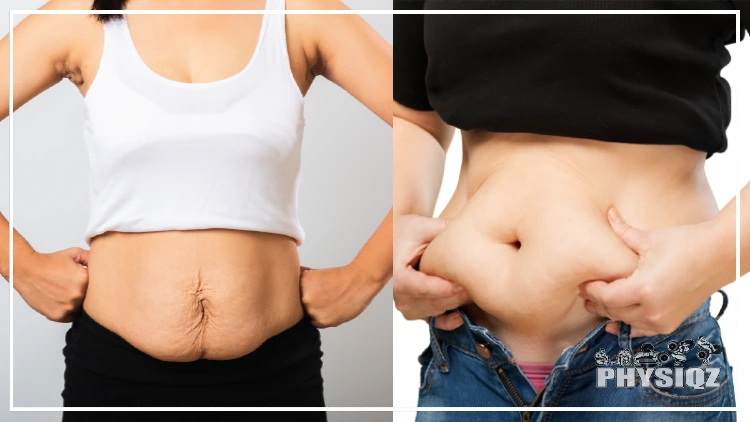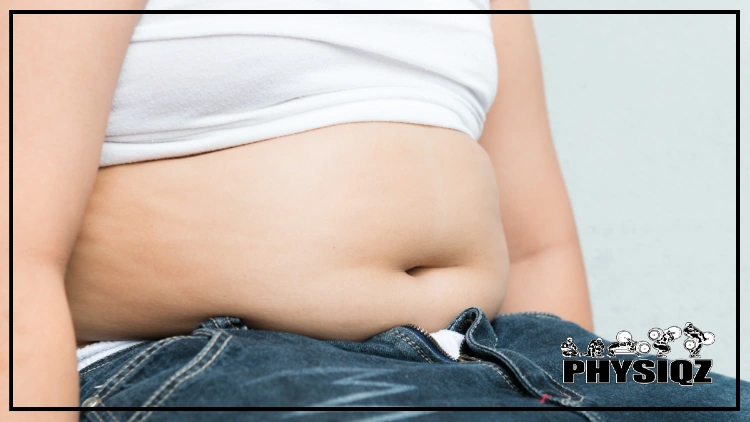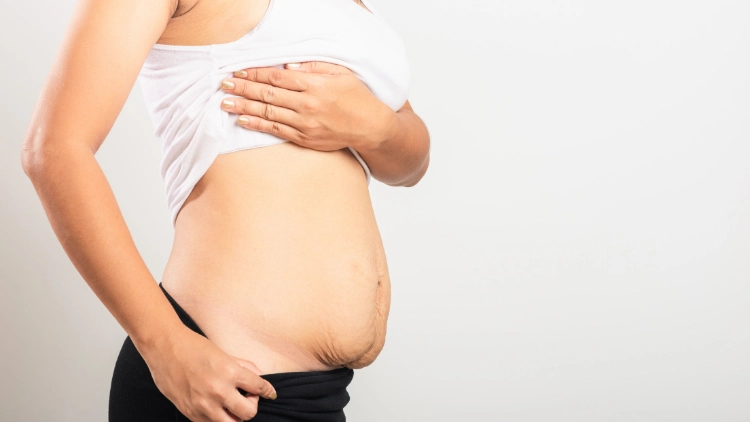
After weight loss, many are curious about how to tell the difference between loose skin and fax since they’re both pinchable and visibly similar.1,2
Luckily though, there’s an easy test to determine whether it is stubborn fat or just excess skin that is lingering and this can be done by yourself by using the visual and pinch test seen below. However, understanding the differences between loose skin, fat, and various types of fats can shed light whether or not the jiggly tummy is fat or skin.
In addition, we’ll cover the best ways to get rid of fat and loose skin through natural, and more invasive methods like surgery.
Understanding the Key Differences Between Loose Skin and Fat
Knowing the differences between loose skin and fat is essential to understanding how to go about ridding either from the body. While it may seem straightforward, skin is skin and fat is fat, it is quite a bit deeper than that.
Skin
Skin is an organ and it covers the body and protects all its inner workings.3 It is made of 3 layers:
- Epidermis: Outer, and thinnest, layer of skin which helps keep the body hydrated, protects from damaging sunlight, viruses, bacteria, creates new skin, and is responsible for making melanin that colors the skin.
- Dermis: This is the skin’s thickest layer which houses sweat glands, nerve endings, connective tissues, hair follicles, and oil glands.
- Subcutaneous Fat: To many people’s surprise, the skin’s innermost layer is actually comprised of fat. This necessary layer of fat aids in shielding bones, pads nerves, and blood vessels, as well as regulating body temperature and uses connective tissue to connect skin to bones and muscles.3,4
While skin is a common finding on every human being, loose skin is when the skin has aged or has stretched for a period of time, collagen and elastin, which is located in the dermis, lose their elastic quality, which in turn removes elasticity from the skin causing it to hang or wrinkle.
The only real harm in loose skin happens when there is an excessive amount that could cause chafing due to friction or unhygienic conditions caused by areas that stay moist.
Fat
Fat is often thought of as a dirty word, especially for those trying to lose weight, but in reality, there are many different types of fat and understanding the function of each will help determine when fat is harmful and how to deal with it.

Source: kwanchaichaiudom via Canva.com5
The 4 types of body fat are brown, white, beige, and pink. Each type of fat has a different function:
- Brown Fat: Brown fat generates heat when stimulated by cold temperatures to keep the body warm; babies are born with a highest percentage of brown fat that decreases as they age.
- White Fat: The most common type of fat, white fat is located throughout the body and is responsible for releasing many types of hormones. However, if too much white fat is present, the hormonal release is disrupted and causes issues such as inflammation and insulin resistance.
- Pink Fat: Only present in women, white fat converts to pink fat during and after gestation and is responsible for the production of breast milk.
- Beige Fat: White fat converts to beige fat when exposed to certain hormones or cold temperatures and has the ability to burn high amounts of other fat.6,7
It is clear that fat isn’t all bad, but white fat can really start to pose a problem when the amount is increased as well as where it decides to take up residence. Fat is located in three primary spots: subcutaneous, visceral, and within muscles, organs, and the nervous system.
The fat that is located within the nervous system, muscles, and organs, regardless of color, is essential for bodily functions. If the body does not have enough of this fat, it can cease to perform.
Visceral fat is the most dangerous place for white fat to exist due to the way it wraps around organs in the abdomen and puts its carrier at high risk of cancer, diabetes, heart disease, stroke, etc.
Subcutaneous fat is the white fat located in the third most layer of skin and makes up a majority of the body’s fat content. The most common places for excess subcutaneous fat to accumulate are the thighs, buttons, upper back, waist, and hips. Too much of this fat can increase the risk of heart disease, diabetes, high blood pressure, etc.
This type of fat also tends to be very soft and can be very difficult to lose during weight loss which makes it easy to confuse with loose skin, so it is important to figure out how to tell the difference between the two.6
Loose Skin vs Fat: How To Tell the Difference Between Loose Skin and Fat
When trying to figure out how to tell the difference between loose skin and fax, the two main determinants are look and feel. So if a problem area exists that doesn’t seem to respond to a diet and exercise routine, these are the “tests” that can be performed:
- Visual Test: If the area looks wrinkled, loose skin is probably the culprit; conversely, if the section observes hangs or droops, there is most likely a layer of fat that is causing the problem.
- Pinch Test: If loose skin is the culprit, when the problem area is pinched, there should be less than an inch of flesh that is easy to pull away from the body; on the other hand, if there is more than an inch, there is most likely stubborn subcutaneous fat still located underneath the surface.
Several Factors Can Lead to Loose Skin or Fat
One reason loose skin and fat can be confused with each other is because they tend to be caused by the same things. While not always the case, both excess skin and fat can be the results of lost weight, age, and pregnancy. This might also raise the issue of whether fat becomes jiggly before you lose it, and the answer is often yes.

Source: Sorapop Udomsri via Canva.com8
As mentioned previously, the second layer of skin contains collagen and elastin which allows the skin to bounce back after being stretched. However, it is by no means magical and has its limits in the form of how quickly weight gain happens, hydration, hormones, and aging.
What this ultimately means is that if the skin is stretched out due to weight gain or pregnancy and then fat is lost, skin may not return to its original state leaving either wrinkled loose skin behind or a small layer of fat that hangs and wants to stick around.
Ways To Lose Belly Fat & Lose Stubborn Weight for Good
Chances are, if someone is trying to figure out how to tell the difference between loose skin and fax, there is most likely stubborn fat hiding somewhere in the body; so, to get rid of it for good, it is essential to come up with a diet and exercise routine to target that tissue as well as looking alternative methods.
Switch Up Your Diet
How much and what is eaten plays a huge part in weight gain and weight loss. Beverages to lose belly fat in 4 days might be a good start, but making bigger lifestyle changes will have a more significant effect in the long run.
If dieting has been a way of life for a while, changing it up might be a catalyst for weight loss. Diet fatigue is a real thing which can cause dieters to unintentionally start overeating, binge eating, and to move less, so taking a short break may be beneficial or consider finding an eating plan that switches things up and could jump start weight loss again.
- Intuitive Eating: Instead of constantly counting calories, try being more mindful of hunger cues and what foods fuel the body best. Focus on eating when hungry and stopping when full to ensure the body is getting what it needs.
- Intermittent Fasting: Think about food less by narrowing the daily eating window to just a few hours. This will naturally reduce the amount of calories consumed in a day.
- Count Calories: If tracking has never been practiced, it may be beneficial to do a comparison between Lose It vs MyFitnessPal and find an app to track to ensure too many calories aren’t being consumed. Achieving and maintaining a calorie deficit can also help you achieve abs without flexing.
- Cut Carbs: Increasing proteins and fat and cutting out carbs and sugar is typically a plan that most bodies like. This doesn’t have to be as extreme as keto, but making these changes could cause the body to burn extra fat.9
Get More Exercise
Bodies crave exercise, so especially if fat loss is the goal, getting the body moving with cardio and weight training is an excellent way to burn calories in the form of fat.

Source: mediaphotos via Canva.com10
Cardio gets the heart pumping and blood flowing and can burn a numerous amount of calories in a short time, especially with high intensity exercise. Finding movement that is fun is one way to stick with the decision to exercise so it may be worth exploring a dance class, biking, skating, swimming, and even brisk walks with a friend.
In combination with cardio, building more muscle can help expedite how quickly fat is burned, which makes the body more efficient. Using a beginner guide for strength training is the ideal place to start as it pinpoints all the large muscle groups that burn the most calories.. Once this plan is put into place, the body will turn into a fat burning machine!
Other Factors
If diet and exercise are in check and there is still fat holding on, there are still a handful of conditions that might be causing the body to not want to let go of that layer of fluff.
- Sleep: Adequate sleep plays a big part in the vital functions the body performs and if enough shut eye isn’t being achieved, the brain and other systems might be fighting back. Sleep, REM sleep (rapid eye movement sleep) in particular, which is a certain sleep stage, is essential for the endocrine system to release hormones that aid in weight loss.11
- Stress: Stress can hinder moods, but it can also cause shifts in hormone levels as well. It may be hard to figure out ways to eliminate of upper belly fat and this is because extra cortisol is released when stress is high and can contribute to high blood sugar as well as weight gain in the belly, especially visceral fat.12
- Rest: Like diet fatigue, lack of rest can cause overexertion when it comes to being overly active. This can ultimately lead to burn out or injury, so taking a break when needed may help to reinvigorate those whose pace has slowed.
- Health: As frustrating as trying to get off stubborn weight can be, it’s important to remember that there could be an underlying health reason which is why the fat just isn’t going anywhere. Consulting with a physician is the ideal way to make sure there are no diseases or conditions preventing the body from doing what it needs to do. Insulin resistance and thyroid conditions are two very common reasons why the body likes to hold onto weight, so ruling out health concerns is crucial.
Last Resort: Surgery and/or Non-Surgical Procedures
Not many people enjoy medical procedures, but if all the above weight loss methods aren’t giving the desired results and it is important to figure out ways to lose belly fat overnight, looking into these procedures, such as body sculpting or liposuction, may help in attaining the desired goal.
Body contouring or non-surgical fat removal, involves devices that send sound, heat, or cold waves through the skin to destroy fat cells. There are a multitude of procedures available, but each type is strictly for targeted areas of fat and can take several sessions.
Alternatively, liposuction is a minimally invasive surgery that strategically removes fat cells from certain areas of the body that tend to hold onto fat like the upper thighs and lower abdomen. This procedure can be completed during one surgery, but is also not meant for removal of excessive amounts of fat.
Top Ways To Get Rid of Loose Skin After Weight Loss
Ridding the body of loose skin after weight loss can potentially be more challenging than fat loss because as the skin ages, as mentioned earlier, it becomes less elastic. Once a dieter determines how to tell the difference between loose skin and fax and pinpoints skin as the problem, the follow things can help it’s saggy appearance:
- Hydrate: Water is essential to keep the body from being dehydrated and help with skin’s elasticity. Drinking enough fluids can rehydrate skin making it look more plump and moisturized.
- Medication: Retinol, as well as other retinoids, can stimulate collagen production in the skin which will reduce lines and wrinkles.13 Retinol can be very drying and damaging as well, so working with a doctor when using this medication is vital.
- Vitamins and Supplements: Hyaluronic acid, vitamin E, vitamin C, folic acid, and collagen all can contribute to the body producing more collagen and potentially help skin firm up. Aain, before taking a medicine cabinet full of supplements, it is important to consult a doctor.
- Building Muscle: Losing weight has the potential to leave behind sagging skin and if the above methods don’t help, replacing some of the fat that was lost with muscle may help fill in the appearance of droopy arms or abs. Try muscle building exercises that will target problem areas such as the inner arms near the biceps. Bicep curls into an overhead lift can help tone and firm the bicep so instead of skin, a well defined muscle will be seen instead.
- If weight loss is extreme, the only thing that can be done to rid the body of that amount of excessive loose skin is skin removal surgery. A surgeon is able to remove entire panels of skin from predetermined areas and pull and stitch the skin to where it is taut again.
Loose skin and subcutaneous fat can both cause problems for those looking to transform their bodies. Thankfully, once someone knows how to tell the difference between loose skin and fax, they can decide the best course of action to reduce or eliminate it.
Frequently Asked Questions
Are Stretch Marks A Sign of Loose Skin?
Stretch marks typically occur during quick changes in the body such as puberty, pregnancy, and muscle gain and can be a good indicator that loose skin may occupy that section of the body at some point if weight is lost. These lines are made by new skin being formed because the skin was stretched, typically quickly, and will not return to original smoothness.
Do I Have to Fix or Remove Loose Skin?
Loose skin is only a problem if the person who has the loose skin is bothered by it. Some people may not like the way it looks, while others may suffer irritation from chafing and infections from overlapping skin, and at that point, that person can take further action.
References
1Udomsri, Sorapop. Canva. Accessed 15 April 2023. <https://www.canva.com/photos/MAFDiF4KCOA-woman-showing-stretch-mark-loose-lower-abdomen-skin-she-fat-afte/>
2Billion Photos. Canva. Accessed 15 April 2023. <https://www.canva.com/photos/MACiNYmoTnA-woman-s-hand-holding-excessive-belly-fat/>
3Rowe, C. (2021, November 19). Anatomy, Skin (Integument), Epidermis – StatPearls. NCBI. Retrieved November 16, 2022, from <https://www.ncbi.nlm.nih.gov/books/NBK470464/>
4Cleveland Clinic. (2022, August 7). Subcutaneous Fat: What You Need to Know About the Fat Beneath Your Skin. Cleveland Clinic. Retrieved November 16, 2022, from <https://my.clevelandclinic.org/health/diseases/23968-subcutaneous-fat>
5kwanchaichaiudom. Canva. Accessed 15 April 2023. <https://www.canva.com/photos/MADBFKNCzEw-belly-fat-boy/>
6Komaroff, A. L. (2022, June 1). What are the different types of body fat? Harvard Health. Retrieved November 17, 2022, from <https://www.health.harvard.edu/staying-healthy/what-are-the-different-types-of-body-fat>
7Dana-Farber Cancer Institute. (2012, July 12). ‘Beige Fat’ Cells Could Help Fight Obesity | Harvard Medical School. Harvard Medical School. Retrieved November 17, 2022, from <https://hms.harvard.edu/news/beige-fat-cells-could-help-fight-obesity>
8Udomsri, Sorapop. Canva. Accessed 15 April 2023. <https://www.canva.com/photos/MAFDiPhsOE0-woman-showing-stretch-mark-loose-lower-abdomen-skin-she-fat-afte/>
9Oh, R., Gilani, B., & Uppaluri, K. (2022, July 11). Low Carbohydrate Diet – StatPearls. NCBI. Retrieved November 17, 2022, from <https://www.ncbi.nlm.nih.gov/books/NBK537084/>
10mediaphotos. Canva. Accessed 15 April 2023. <https://www.canva.com/photos/MAEE5OmGl34-fat-burning-exercise/>
11Kim, T. W., Jeong, J.-H., & Hong, S.-C. (2015, March). The Impact of Sleep and Circadian Disturbance on Hormones and Metabolism. NCBI. Retrieved November 17, 2022, from <https://www.ncbi.nlm.nih.gov/pmc/articles/PMC4377487/>
12Peart, K. (2000, September 22). Study: Stress may cause excess abdominal fat in otherwise slender women. YaleNews. Retrieved November 17, 2022, from <https://news.yale.edu/2000/09/22/study-stress-may-cause-excess-abdominal-fat-otherwise-slender-women>
13Harvard Health Publishing. (2022, March 3). Do retinoids really reduce wrinkles? Harvard Health. Retrieved November 17, 2022, from <https://www.health.harvard.edu/staying-healthy/do-retinoids-really-reduce-wrinkles>